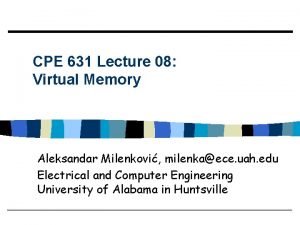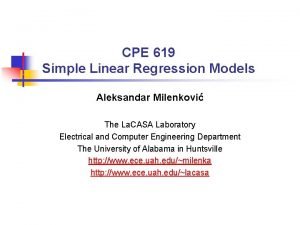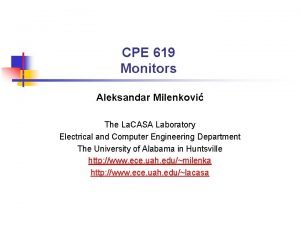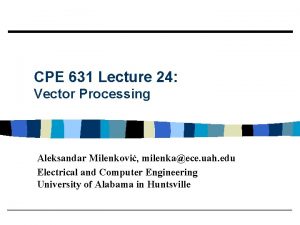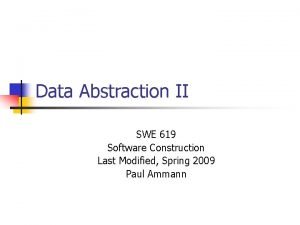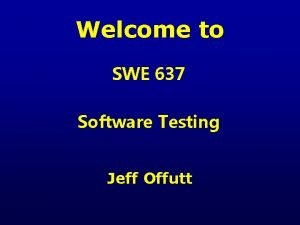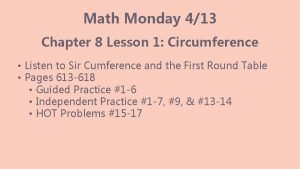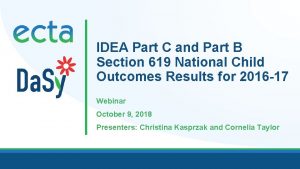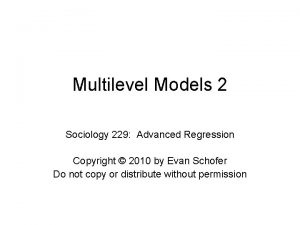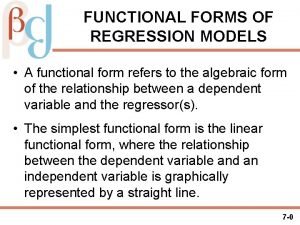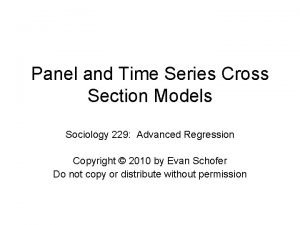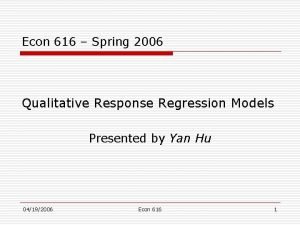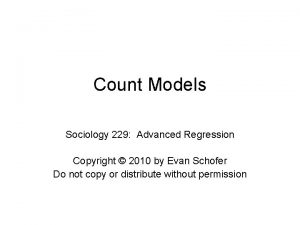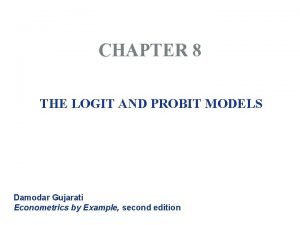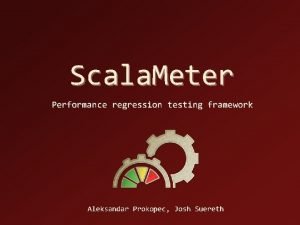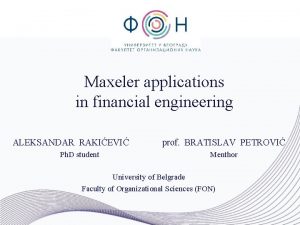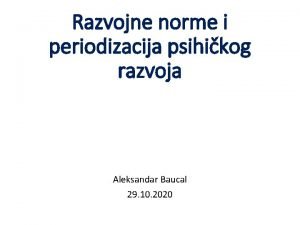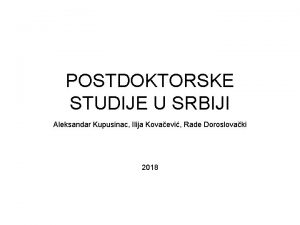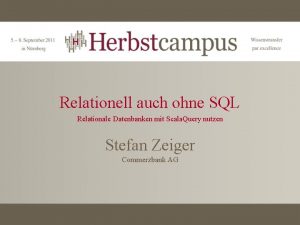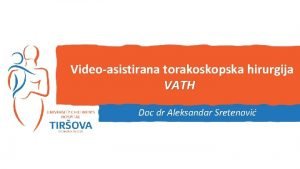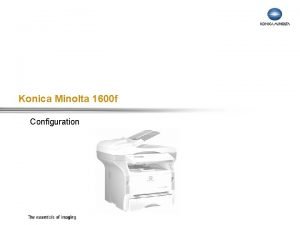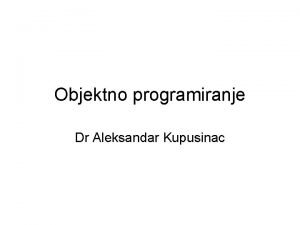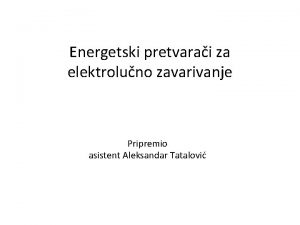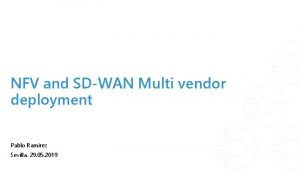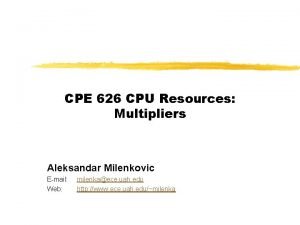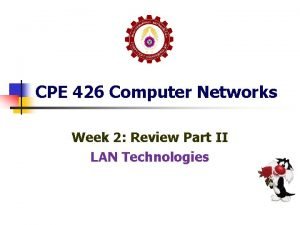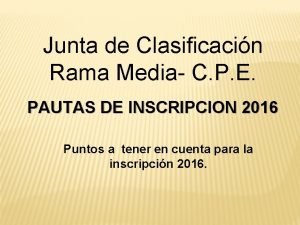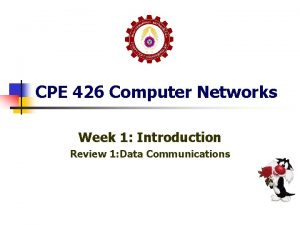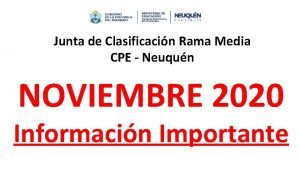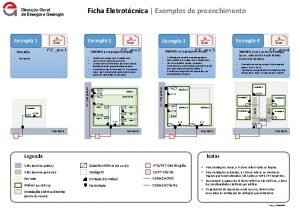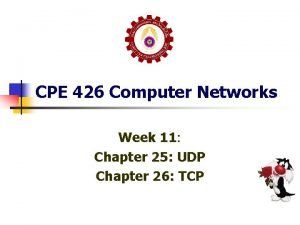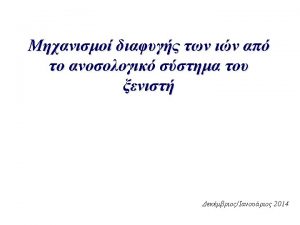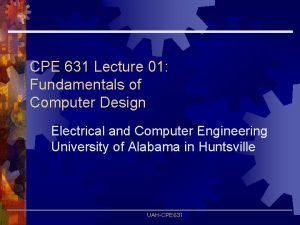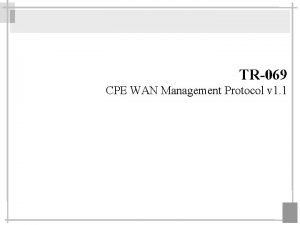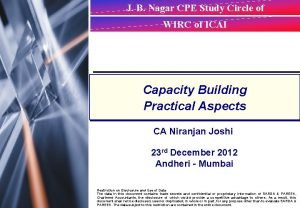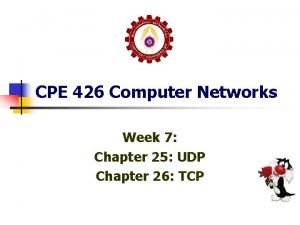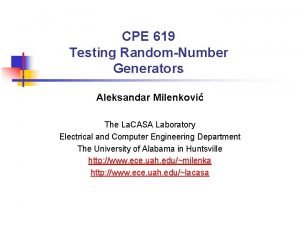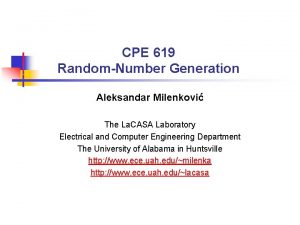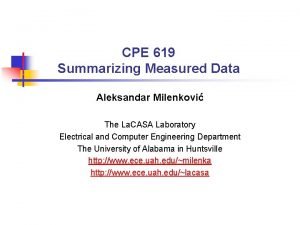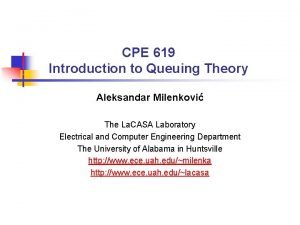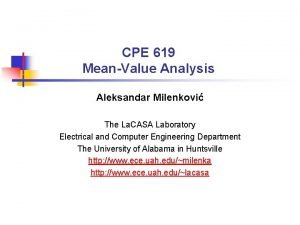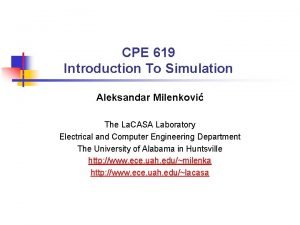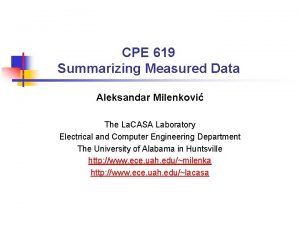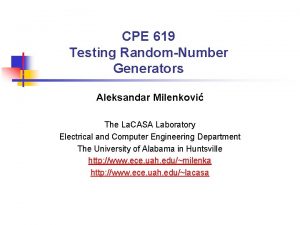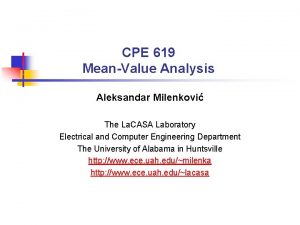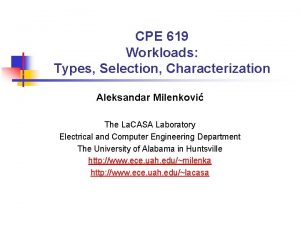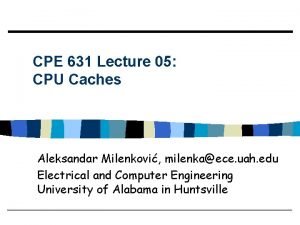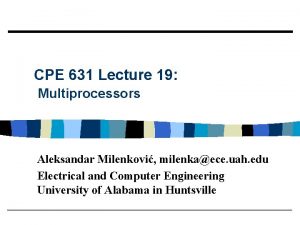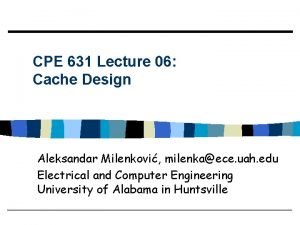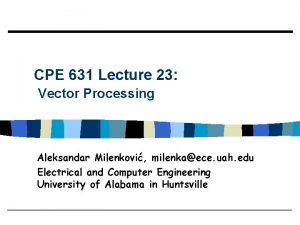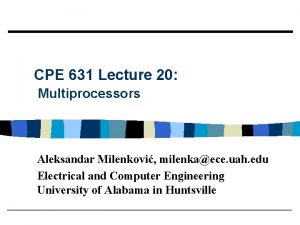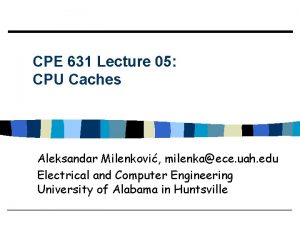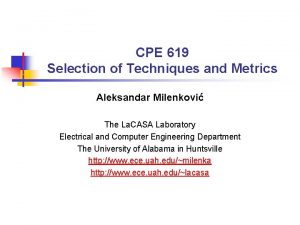CPE 619 Other Regression Models Aleksandar Milenkovi The
































































- Slides: 64

CPE 619 Other Regression Models Aleksandar Milenković The La. CASA Laboratory Electrical and Computer Engineering Department The University of Alabama in Huntsville http: //www. ece. uah. edu/~milenka http: //www. ece. uah. edu/~lacasa

Overview n n n Multiple Linear Regression: More than one predictor variables Categorical Predictors: Predictor variables are categories such as CPU type, disk type, and so on Curvilinear Regression: Relationship is nonlinear Transformations: Errors are not normally distributed or the variance is not homogeneous Outliers Common Mistakes in Regression 2

Multiple Linear Regression Models n Given a sample of n observations with k predictors 3

Vector Notation n In vector notation, we have: or All elements in the first column of X are 1. See Box 15. 1 for regression formulas. 4

Multiple Linear Regression n Where, n n n y – a column vector of n observed values X – an n row by (k+1) column matrix b – a column vector with (k+1) elements e – a column vector of n error terms Parameter estimation 5

Multiple Linear Regression (cont’d) n Variations n Coefficient of determination, multiple correlation 6

Multiple Linear Regression (cont’d) n Degrees of freedom n Analysis of variance n Regression is significant is MSR/MSE is greater than F[1 - , k, n-k-1] 7

Multiple Linear Regression (cont’d) n Standard deviation of parameters n Regression is significant is MSR/MSE is greater than F[1 - , k, n-k-1] 8

Multiple Linear Regression (cont’d) n Prediction n Standard deviation n Correlations among predictors 9

Model Assumptions n n n Errors are independent and identically distributed normal variates with zero mean Errors have the same variance for all values of the predictors Errors are additive Xi’s and y are linearly related Xi’s are nonstochastic and are measured without error 10

Example 15. 1 n Seven programs were monitored to observe their resource demands. In particular, the number of disk I/O's, memory size (in k. Bytes), and CPU time (in milliseconds) were observed 11

Example 15. 1 (cont’d) n In this case: 12

Example 15. 1 (cont’d) n The regression parameters are: n The regression equation is: 13

Example 15. 1 (cont’d) n From the table we see that SSE is: 14

Example 15. 1 (cont’d) n An alternate method to compute SSE is to use: n For this data, SSY and SS 0 are: n Therefore, SST and SSR are: 15

Example 15. 1 (cont’d) n The coefficient of determination R 2 is: n Thus, the regression explains 97% of the variation of y Coefficient of multiple correlation: n Standard deviation of errors is: n 16

Example 15. 1 (cont’d) n Standard deviations of the regression parameters are: n The 90% t-value at 4 degrees of freedom is 2. 132 n Note: None of the three parameters is significant at a 90% confidence level 17

Example 15. 1 (cont’d) n A single future observation for programs with 100 disk I/O's and a memory size of 550: n Standard deviation of the predicted observation is: n 90% confidence interval using the t value of 2. 132 is: 18

Example 15. 1 (cont’d) n n Standard deviation for a mean of large number of observations is: 90% confidence interval is: 19

Analysis of Variance (ANOVA) n n n Test the hypothesis that SSR is less than or equal to SSE Degrees of freedom for a sum = Number of independent values required to compute the sum Assuming n n n Errors are independent and normally distributed Þ y's are also normally distributed x's are nonstochastic Þ Can be measured without errors Þ Various sums of squares have a chi-square distribution with the degrees of freedom as given above 20

F-Test n n n Given two sums of squares SSi and SSj with i and j degrees of freedom, the ratio (SSi/ i)/(SSj/ j) has an F distribution with i numerator degrees of freedom and j denominator degrees of freedom Hypothesis that the sum SSi is less than or equal to SSj is rejected at significance level, if the ratio (SSi/ i)/(SSj/ j) is greater than the 1 - quantile of the F-variate Thus, the computed ratio is compared with F[1 - ; i; vj] This procedure is also known as F-test The F-test can be used to check: Is SSR is significantly higher than SSE? Þ Use F-test Þ Compute (SSR/ R)/(SSE/ e) = MSR/MSE 21

F-Test (cont’d) and n n MSE = Variance of Error, MSR = Mean Square of the Regression MSR/MSE has F[k, n-k-1] distribution If the computed ratio is greater than the value read from the Ftable, the predictor variables are assumed to explain a significant fraction of the response variation ANOVA Table for Multiple Linear Regression 22

F-Test (cont’d) n n n F-test is also equivalent to testing the null hypothesis that y doesn't depend upon any xj against an alternate hypothesis that y depends upon at least one xj and therefore, at least one bj 0 If the computed ratio is less than the value read from the table, the null hypothesis cannot be rejected at the stated significance level In simple regression models, If the confidence interval of b 1 does not include zero Þ Parameter is nonzero Þ Regression explains a significant part of the response variation Þ F-test is not required 23

Example 15. 2 n n n For the Disk-Memory-CPU data of Example 15. 1 Computed F ratio > F value from the table Þ Regression does explain a significant part of the variation Note: Regression passed the F test Þ Hypothesis of all parameters being zero cannot be accepted. However, none of the regression parameters are significantly different from zero. This contradiction Þ Problem of multicollinearity 24

Problem of Multicollinearity n n n Two lines are said to be collinear if they have the same slope and same intercept These two lines can be represented in just one dimension instead of the two dimensions required for lines which are not collinear Two collinear lines are not independent When two predictor variables are linearly dependent, they are called collinear Collinear predictors Þ Problem of multicollinearity Þ Contradictory results from various significance tests High Correlation Þ Eliminate one variable and check if significance improves 25

Example 15. 3 n n n For the data of Example 15. 2, n=7, S x 1 i=271, S x 2 i=1324, S x 1 i 2=1385, S x 2 i 2=326, 686, S x 1 ix 2 i=67, 188 Correlation is high Þ Programs with large memory sizes have more I/O's In Example 14. 1, CPU time on number of disk I/O's regression was found significant 26

Example 15. 3 (cont’d) n n n Similarly, in Exercise 14. 3, CPU time is regressed on the memory size and the resulting regression parameters are found to be significant Thus, either the number of I/O's or the memory size can be used to estimate CPU time, but not both Lesson learned: n n Adding a predictor variable does not always improve a regression If the variable is correlated to other predictors, it may reduce the statistical accuracy of the regression Try all 2 k possible subsets and choose the one that gives the best results with small number of variables Correlation matrix for the subset chosen should be checked 27

Regression with Categorical Predictors n n n Note: If all predictor variables are categorical, use one of the experimental design and analysis techniques for statistically more precise (less variant) results Use regression if most predictors are quantitative and only a few predictors are categorical Two Categories: bj = difference in the effect of the two alternatives bj = Insignificant Þ Two alternatives have similar performance Alternatively: bj = Difference from the average response Difference of the effects of the two levels is 2 bj 28

Categorical Predictors (cont’d) n Three Categories: Incorrect: n This coding implies an order Þ B is half way between A and C This may not be true Recommended: Use two predictor variables 29

Categorical Predictors (cont’d) Thus, n This coding does not imply any ordering among the types. Provides an easy way to interpret the regression parameters. 30

Categorical Predictors (cont’d) n n The average responses for the three types are: Thus, b 1 represents the difference between type A and C. b 2 represents the difference between type B and C. b 0 represents type C. 31

Categorical Predictors (cont’d) n n n Level = Number of values that a categorical variable can take To represent a categorical variable with k levels, define k-1 binary variables: kth (last) value is defined by x 1= x 2= L = xk-1= 0. b 0 = Average response with the kth alternative. bj = Difference between alternatives j and k. If one of the alternatives represents the status quo or a standard against which other alternatives have to be measured, that alternative should be coded as the kth alternative 32

Case Study 15. 1: RPC performance n RPC performance on Unix and Argus where, y is the elapsed time, x 1 is the data size and 33

Case Study 15. 1 (cont’d) n n n All three parameters are significant. The regression explains 76. 5% of the variation Per byte processing cost (time) for both operating systems is 0. 025 millisecond Set up cost is 36. 73 milliseconds on ARGUS which is 14. 927 milliseconds more than that with UNIX 34

Differing Conclusions n n n Case Study 14. 1 concluded that there was no significant difference in the set up costs. The per byte costs were different Case Study 15. 1 concluded that per byte cost is same but the set up costs are different Which conclusion is correct? n n n Need system (domain) knowledge. Statistical techniques applied without understanding the system can lead to a misleading result Case Study 14. 1 was based on the assumption that the processing as well as set up in the two operating systems are different Þ Four parameters The data showed that the setup costs were numerically indistinguishable 35

Differing Conclusions (cont’d) n n The model used in Case Study 15. 1 is based on the assumption that the operating systems have no effect on per byte processing This will be true if the processing is identical on the two systems and does not involve the operating systems Only set up requires operating system calls. If this is, in fact, true then the regression coefficients estimated in the joint model of this case study 15. 1 are more realistic estimates of the real world On the other hand, if system programmers can show that the processing follows a different code path in the two systems, then the model of Case Study 14. 1 would be more realistic 36

Curvilinear Regression n If the relationship between response and predictors is nonlinear but it can be converted into a linear form Þ curvilinear regression Example: n Taking a logarithm of both sides we get: n n Thus, ln x and ln y are linearly related. The values of ln b and a can be found by a linear regression of ln y on ln x 37

Curvilinear Regression: Other Examples n n If a predictor variable appears in more than one transformed predictor variables, the transformed variables are likely to be correlated Þ multicollinearity Try various possible subsets of the predictor variables to find a subset that gives significant parameters and explains a high percentage of the observed variation 38

Example 15. 4 n Amdahl's law: I/O rate is proportional to the processor speed. For each instruction executed there is one bit of I/O on the average. 39

Example 15. 4 (cont’d) n Let us fit the following curvilinear model to this data: n Taking a log of both sides we get: 40

Example 15. 4 (cont’d) n n n Both coefficients are significant at 90% confidence level The regression explains 84% of the variation At this confidence level, we can accept the hypothesis that the relationship is linear since the confidence interval for b 1 includes 1. 41

Example 15. 4 (cont’d) n Errors in log I/O rate do seem to be normally distributed 42

Transformations n Transformation: Some function of the measured response variable y is used. For example, Transformation is a subset of the curvilinear regression. However, the ideas apply to non-regression model as well. 1. Physical considerations Þ Transformation For example, if response = inter-arrival times y and it is known that the number of requests per unit time (1/y) has a linear relationship to a predictor 2. If the range of the data covers several orders of magnitude and the sample size is small. That is, if is large 3. If the homogeneous variance (homoscedasticity) assumption of the residuals is violated 43

Transformations (cont’d) n scatter plot shows non-homogeneous spread Þ Residuals are still functions of the predictors Plot the standard deviation of residuals at each value of as a function of the mean If s and the mean : n Then a transformation of the form: n n may help solve the problem 44

Useful Transformations n Log Transformation: Standard deviation s is a linear function of the mean (s = a ) w = ln y and, therefore: 45

Useful Transformations (cont’d) n n Logarithmic transformation is useful only if the ratio is large For a small range the log function is almost linear Square Root Transformation: For a Poisson distributed variable: Variance versus mean will be a straight line helps stabilize the variance 46

Useful Transformations (cont’d) n n Arc Sine Transformation: If y is a proportion or percentage, may be helpful Omega Transformation: This transformation is popularly used when the response y is a proportion n n The transformed values w's are said to be in units of deci-Bells. The term comes from signaling theory where the ratio of output power to input power is measured in d. Bs. Omega transformation converts fractions between 0 and 1 to values between - to + This transformation is particularly helpful if the fractions are very small or very large If the fractions are close to 0. 5, a transformation may not be required 47

Useful Transformations (cont’d) n Power Transformation: ya is regressed on the predictor variables n Standard deviation of residuals se is proportional to a=-1 and general a, respectively. 48

Useful Transformations (cont’d) n Shifting: y+c (with some suitable c) may be used in place of y. n Useful if there are negative or zero values and if the transformation function is not defined for these values. 49

Box-Cox Transformations n If the value of the exponent a in a power transformation is not known, Box-Cox family of transformations can be used: Where g is the geometric mean of the responses: n n The Box-Cox transformation has the property that w has the same units as the response y for all values of the exponent a. All real values of a, positive or negative can be tried. The transformation is continuous even at zero, since: 50

Box-Cox Transformations (cont’d) n n Use a that gives the smallest SSE. Use simple values for a. If if a=0. 52 is found to give the minimum SSE and the SSE at a=0. 5 is not significantly higher, the latter value may be preferable 100(1 - ) confidence interval for a: Where, is the minimum SSE, and is the number of degrees of freedom for the errors If the confidence interval for a includes a = 1, then the hypothesis that the relationship is linear cannot be rejected Þ No need for the transformation 51

Case Study 15. 2: Garbage collection n The garbage collection time for various values of heap sizes 52

Case Study 15. 2: Garbage collection n n The points do not appear to be close to the straight line. The analyst hypothesizes 53

Case Study 15. 2 (cont’d) n n Is exponent on time is different than a half? Þ Use Box-Cox transformations with “a” ranging from -0. 4 to 0. 8 The minimum SSE of 2049 occurs at a = 0. 45 54

Case Study 15. 2 (cont’d) n n n Since 0. 95 -quantile of a t variate with 10 degrees of freedom is 1. 812 The SSE = 2271 line intersects the curve at a = 0. 2465 and a = 0. 5726 90% confidence interval for a is (0. 2465, 0. 5726). Since the interval includes 0. 5, we cannot reject the hypothesis that the exponent is 0. 5 55

Outliers n n n Any observation that is atypical of the remaining observations may be considered an outlier Including the outlier in the analysis may change the conclusions significantly Excluding the outlier from the analysis may lead to a misleading conclusion, if the outlier in fact represents a correct observation of the system behavior. A number of statistical tests have been proposed to test if a particular value is an outlier. Most of these tests assume a certain distribution for the observations. If the observations do not satisfy the assumed distribution, the results of the statistical test would be misleading Easiest way to identify outliers is to look at the scatter plot of the data 56

Outliers (cont’d) n n n Any value significantly away from the remaining observations should be investigated for possible experimental errors Other experiments in the neighborhood of the outlying observation may be conducted to verify that the response is typical of the system behavior in that operating region Once the possibility of errors in the experiment has been eliminated, the analyst may decide to include or exclude the suspected outlier based on the intuition One alternative is to repeat the analysis with and without the outlier and state the results separately Another alternative is to divide the operating region into two (or more) sub-regions and obtain a separate model for each subregion 57

Common Mistakes in Regression 1. Not verifying that the relationship is linear 2. Relying on automated results without visual verification • In all these cases, R 2 = High • High R 2 is necessary but not sufficient for a good model. 58

Common Mistakes in Regression (cont’d) 3. Attaching importance to numerical values of regression parameters n n 4. 5. CPU time in seconds = 0. 01 (Number of disk I/O's) + 0. 001 (Memory size in kilobytes) 0. 001 is too small > memory size can be ignored CPU time in milliseconds = 10 (Number of disk I/O's) + 1(Memory size in kilobytes) CPU time in seconds = 0. 01 (Number of disk I/O's) + 1 (Memory size in Mbytes) Not specifying confidence intervals for the regression parameters Not specifying the coefficient of determination 59

Common Mistakes in Regression (cont’d) 6. Confusing the coefficient of determination and the coefficient of correlation R=Coefficient of correlation, R 2= Coefficient of determination R=0. 8, R 2=0. 64 Þ Regression explains only 64% of variation and not 80% 7. Using highly correlated variables as predictor variable Analysts often start a multi-linear regression with as many predictor variables as possible Þ severe multicollinearity problems. 8. Using regression to predict far beyond the measured range Predictions should be specified along with their confidence intervals 60

Common Mistakes in Regression (cont’d) 9. Using too many predictor variables k predictors Þ 2 k-1 subsets Subset giving the minimum R 2 is the best. But, other subsets that are close may be used instead for practical or engineering reasons. For example, if the second best has only one variable compared to five in the best, the second best may the preferred model. 10. Measuring only a small subset of the complete range of operation e. g. , 10 or 20 users on a 100 user system 61

Common Mistakes in Regression (cont’d) 11. Assuming that a good predictor variable is also a good control variable n n Correlation Þ Can predict with a high precision > Can control response with predictor For example, the disk I/O versus CPU time regression model can be used to predict the number of disk I/O's for a program given its CPU time. However, reducing the CPU time by installing a faster CPU will not reduce the number of disk I/O's. w and y both controlled by x Þ w and y highly correlated and would be good predictors for each other. 62

Common Mistakes in Regression (cont’d) n n The prediction works both ways: w can be used to predict y and vice versa The control often works only one way: x controls y but y may not control x 63

Summary n n n Too many predictors may make the model weak Categorical predictors are modeled using binary predictors Curvilinear regression can be used if a transformation gives linear relationship Transformation: s = g(y) Outliers: Use your system knowledge. Check measurements Common mistakes: No visual verification, control vs correlation 64
 Milenkovi
Milenkovi Milenkovi
Milenkovi Milenkovi
Milenkovi Milenkovi
Milenkovi Casa cpe
Casa cpe Popcvm
Popcvm Swe 619
Swe 619 Swe 619 gmu
Swe 619 gmu Jeff offutt
Jeff offutt Requisitos de los títulos valores
Requisitos de los títulos valores Lesson 2 reteach area of circles answer key
Lesson 2 reteach area of circles answer key Idea part b section 619
Idea part b section 619 Sf 619
Sf 619 Xkcd
Xkcd Swe 619
Swe 619 Round 2 617 to the nearest ten
Round 2 617 to the nearest ten Xkcd #619
Xkcd #619 Linear regression vs multiple regression
Linear regression vs multiple regression Multiple regression vs linear regression
Multiple regression vs linear regression Survival analysis vs logistic regression
Survival analysis vs logistic regression Logistic regression vs linear regression
Logistic regression vs linear regression Advanced regression and multilevel models
Advanced regression and multilevel models Double log functional form
Double log functional form Time fixed effects
Time fixed effects Qualitative response regression models
Qualitative response regression models Advanced regression models
Advanced regression models Qualitative response regression models ppt
Qualitative response regression models ppt Types of regression models
Types of regression models Aleksandar kartelj matf
Aleksandar kartelj matf Aleksandar plamenac
Aleksandar plamenac Aleksandar stefanovic sorbonne
Aleksandar stefanovic sorbonne Aleksandar nikcevic
Aleksandar nikcevic Aleksandar prokopec
Aleksandar prokopec Hefestion i aleksandar
Hefestion i aleksandar Aleksandar rakicevic
Aleksandar rakicevic Aleksandar erceg
Aleksandar erceg Aleksandar baucal
Aleksandar baucal Aleksandar kupusinac
Aleksandar kupusinac Aleksandar prokopec
Aleksandar prokopec Aleksandar kuzmanovic flashback
Aleksandar kuzmanovic flashback Dr aleksandar sretenovic
Dr aleksandar sretenovic Configurator konica minolta
Configurator konica minolta Aleksandar kupusinac
Aleksandar kupusinac Aleksandar.krizo
Aleksandar.krizo Aleksandar tatalovic
Aleksandar tatalovic What is the difference between model and semi modals
What is the difference between model and semi modals Self-initiated other-repair
Self-initiated other-repair Multi-vendor deployment
Multi-vendor deployment Calendrier cpe 2021
Calendrier cpe 2021 Cpe
Cpe Bisk cpe
Bisk cpe Jicpa cpe
Jicpa cpe Cpe 426
Cpe 426 Cpe rama media
Cpe rama media Cpe426
Cpe426 Listados interinatos y suplencias 2021 neuquén
Listados interinatos y suplencias 2021 neuquén Exemplificação de preenchimento da ficha eletrotécnica
Exemplificação de preenchimento da ficha eletrotécnica Cpe crocus
Cpe crocus Unr 365
Unr 365 Cpe426
Cpe426 Cpe
Cpe Cpe
Cpe Cpe wan management protocol
Cpe wan management protocol Jb nagar cpe study circle of wirc of icai
Jb nagar cpe study circle of wirc of icai Cpe426
Cpe426

